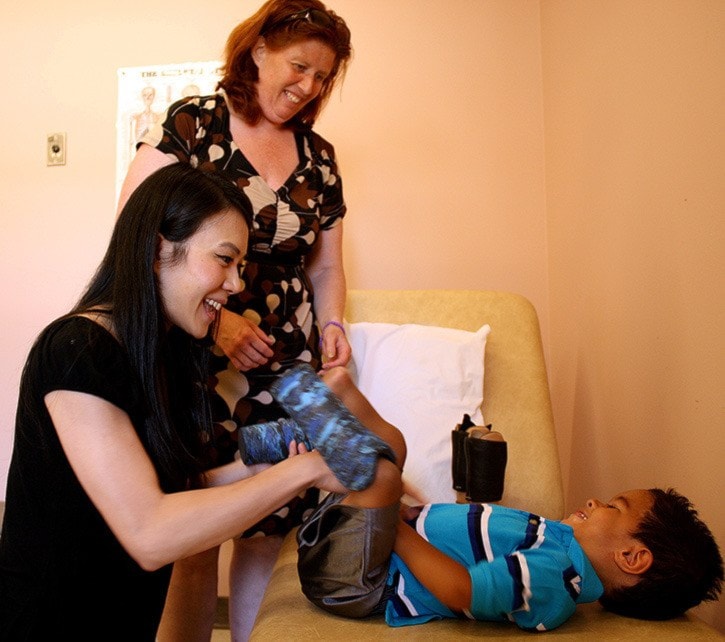Two-year-old Tytan Beckford darts down the hallway of Queen Alexandra’s Fisher Building towards the laughs of his older sister, Zamira.
As he weaves around the cumbersome adults in his way, Tytan looks the part of any excited toddler ready for a game of hide and seek.
“Right now, Tytan quite likes walking on the end of his legs, but the rule I’ve got is if he goes outside, he has to put something over them,” says mother Moira Beckford following close behind.
When Moira was 20 weeks pregnant, an ultrasound determined Tytan was missing fibula bones in both his tiny legs. The prognosis meant one of two options: years of painful reconstructive surgery – a move rarely recommended for bilateral fibular hemimelia – or the removal of most of Tytan’s feet before his first birthday.
Moira and her orthopaedic surgeon, Dr. Norgrove Penny, chose the latter option.
“It was really hard to decide to take a part of your child’s body off,” Moira says. “With reconstruction, you’re in for a lifetime of surgeries, but the kids who get amputation get on with their life.”
Penny said Tytan’s condition isn’t incredibly rare – the most famous case is likely runner Oscar Pistorius – and children lead relatively normal lives after surgery.
“We take off the front part of the foot, but the tissue on the back of the foot is very specialized for weight-bearing. If we can align that tissue with the bone, that’s ideal. And that’s what we’ve done in Tytan’s case,” Penny said.
Tytan’s monthly regimen includes two visits to the Queen Alexandra Centre for Children’s Health, where prosthetist and orthotic resident Stephanie Lung acts as both healthcare provider and confidant to the Beckfords.
She said Tytan’s bulbous feet are beneficial because they allow for “self-suspension” of any prosthesis. Other amputees can require thigh corsets and pin-lock mechanisms to keep an artificial limb attached.
“When Tytan’s older as well, the prosthesis is going to hold onto him naturally,” says Lung, examining the delicate skin around his legs for blisters.
The Beckfords lovingly refer to Lung as the newest member of the family. This week, she’s pleased to see Tytan attempting to slip on his “stubbies,” the foam and plastic stilts that raise his centre of gravity to better replicate having feet.
“I see kids a lot more often than I do adults,” she says. “I need to see Tytan often to make sure everything’s fitting correctly and determine whether or not we need adjustments due to his growth.”
Prosthetic replacements can be outgrown annually during the first few years of an amputee’s life.
Prosthetists like Lung do as much as possible to ensure the equipment has an enduring lifespan.
The services are punishingly expensive for most families: a single prosthetic leg can cost up to $7,000, most of which isn’t covered by Pharmacare in Tytan’s case. Speciality limbs for swimming or other sport can cost more.

Moira was still pregnant when The War Amps reached out to her and offered a network of financial and emotional support. The War Amps’ charitable focus has shifted over the decades to include not just veterans but thousands of children across Canada.
Moira knows only two others in B.C. with Tytan’s condition: the trio and their families met in person for the first time at The War Amps annual conference earlier this year in Vancouver.
“Matteo, who’s seven, was playing with Tytan, showing him how to put on his legs when they met,” she says. “I just know they’re going to have this amazing friendship as they grow up. It’s like having an older brother.”
Rob Larman, director of The War Amps Playsafe/Drivesafe program, lives The War Amps’ motto, “Amputees helping amputees,” as he lost a leg in a rail accident at 14 years old. He said no other country in the world has an organization that offers the same level of amputee support as The War Amps.
“The financial support, counselling, seminars, safety campaigns across the country – you name it, we do it,” Larson says. “The legacy that’s being left behind by our veteran members is truly a legacy of love for these kids.”
The War Amps also covers the Beckfords’ travel expenses to and from appointments as well as coverage to attend conferences.
Tytan’s surgeon said The War Amps are vital to his profession and patients.
“We wouldn’t be able to do what we do without them,” Penny says. “What I really love is the counselling process where the older kids have been through this, and for the parents to see a teenager who had an amputated foot who now lives a very productive life … it shows other kids everything’s going to be OK.”
Moira plans to run a War Amps booth at the Coast Capital Savings Victoria TeenFest at Pearkes Rec Centre in November to help increase awareness.
Zamira, 8, is spearheading the Playsafe campaign at Quadra elementary to inform her classmates about Tytan’s reality and how losing limbs can be prevented. The school’s families are already rallying around the Beckfords, said Tytan’s grandfather Ted Baxter.
“He goes to school to pick up Zamira and they all know who he is, they adore him. They all play together,” Baxter says.

Although the family is asked 15 to 20 times per day about Tytan’s condition, Moira embraces each instance as an opportunity to educate.
“The kids just want to know why he has no feet,” Moira says. “It’s nothing more than that. … It’s been such an emotional journey, but I have friends and family who understand, and we’ve got amazing support behind us with The War Amps. … We know we’re going to be OK.”
Look for Part 2 of this series in the next edition of Saanich News as we explore how prostheses, braces and specialty wheelchairs are made.
dpalmer@vicnews.com
